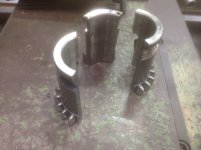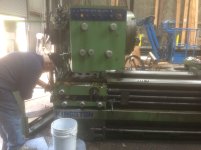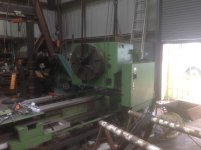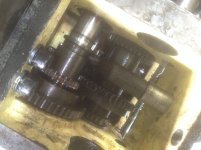jackie schmidt
New member
One of our larger lathes went down two weeks ago, a 28 ft Kingston that we Bought new about eight yearsago. One of my machinist said he heard a loud "pop" in the feed quick change, and the Lathe stopped feeding.
We had to tear into the feed box. But in order to take the access cover off, (it's on top), you have to lift the entire headstock assembly up enough to get in there and work.
This we did , and found a gear broke in several pieces. Nothing else seemed amiss, so we ordered a gear from Kingston.
It arrived yesterday, and me and my younger brother have been putting the thing back together.
I talked to Kingston, inquiring as to why this gear broke. It looks awfully light or such a heavy application. In fact, every gear in the feed box quick change looks too light for this machine. Something like this really should not happen.
Anyway, I thought I would share some pictures. It should be up and running again this afternoon.
It's been a while since I tore into a machine like this. We called a machinery repair here in Houston, they said it would be three weeks. So we just decided to do the repair ourselves.
http://benchrest.com/attachment.php?attachmentid=21412&stc=1&d=1535565678
http://benchrest.com/attachment.php?attachmentid=21413&stc=1&d=1535565728
http://benchrest.com/attachment.php?attachmentid=21414&stc=1&d=1535565776
http://benchrest.com/attachment.php?attachmentid=21416&stc=1&d=1535566015
http://benchrest.com/attachment.php?attachmentid=21415&stc=1&d=1535565874
http://benchrest.com/attachment.php?attachmentid=21417&stc=1&d=1535566212
We had to tear into the feed box. But in order to take the access cover off, (it's on top), you have to lift the entire headstock assembly up enough to get in there and work.
This we did , and found a gear broke in several pieces. Nothing else seemed amiss, so we ordered a gear from Kingston.
It arrived yesterday, and me and my younger brother have been putting the thing back together.
I talked to Kingston, inquiring as to why this gear broke. It looks awfully light or such a heavy application. In fact, every gear in the feed box quick change looks too light for this machine. Something like this really should not happen.
Anyway, I thought I would share some pictures. It should be up and running again this afternoon.
It's been a while since I tore into a machine like this. We called a machinery repair here in Houston, they said it would be three weeks. So we just decided to do the repair ourselves.
http://benchrest.com/attachment.php?attachmentid=21412&stc=1&d=1535565678
http://benchrest.com/attachment.php?attachmentid=21413&stc=1&d=1535565728
http://benchrest.com/attachment.php?attachmentid=21414&stc=1&d=1535565776
http://benchrest.com/attachment.php?attachmentid=21416&stc=1&d=1535566015
http://benchrest.com/attachment.php?attachmentid=21415&stc=1&d=1535565874
http://benchrest.com/attachment.php?attachmentid=21417&stc=1&d=1535566212
Attachments
Last edited:








